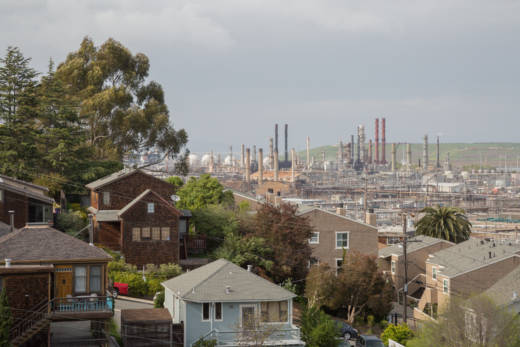"It's definitely an indication that something was going on and there could definitely be something that could have potentially impacted San Francisco," said Sawyer, adding that the winds after both flares were gusting toward the city.
"There's something that did not work properly," Sawyer said.
Normally, hydrogen sulfide is burned as it goes through a refinery's flares, a process that turns the gas into sulfur dioxide.
But, in these two incidents, air monitors picked up high levels of hydrogen sulfide. If that chemical came through the flares or somewhere else in the facility, that's a serious problem, Sawyer said.
About a week after the flaring incidents and ensuing series of odor complaints, Chevron sent three preliminary reports to Contra Costa County's health services agency.
"This incident highlights the huge risks that come with having an oil refinery in such a heavy populated area," said the Center for Biological Diversity's Kretzmann. "It's also another example of communities of color unjustly bearing the brunt of dangerous air pollution," he said.
Timeline of Refinery Problems, Flares and Toxic Gas Readings
It was at 11:45 p.m. on Tuesday, Dec. 27, when Chevron's first malfunction took place, involving a problem with a device that knocks out water from a gas compressor. The refinery sent gas to its flares 38 minutes later, according to the company.
Just minutes after that, at 12:45 a.m., 451 parts per billion (ppb) of hydrogen sulfide were detected at one of the company's ground-level monitoring stations at Point Richmond.
At 2 a.m. people in San Francisco began calling PG&E and the city's Fire Department, complaining of a sulfurlike smell.
It took Chevron 13 hours to notify local emergency agencies, Contra Costa County health officials and local air regulators about the high-level readings, one of the company's reports said.
"That is a problem," Sawyer said.
The second flaring incident started at 8:45 p.m. on Wednesday, Dec. 28, after a problem with a refinery lube oil compressor. At 10:30 p.m., elevated levels of the toxic gas were detected at the same monitoring station.
At 11 p.m. residents in San Francisco began complaining of an odor that smelled like rotten eggs, according to fire and PG&E officials.
Detecting Higher Levels of Hydrogen Sulfide
Chevron's air monitoring device has a detection range of up to 500 ppb of hydrogen sulfide.
"When you get up to 500 parts per billion, it's going to be very strong odors," said Sawyer. He added that people who inhale hydrogen sulfide at those levels can feel nauseous and get headaches.
In addition, the reading violates standards set by the Bay Area Air Quality Management District (BAAQMD).
However, they would not trigger a federal violation of air limits, according to Michele Huitric, a spokeswoman for the U.S. Environmental Protection Agency, Region 9, based in San Francisco.
Hydrogen sulfide presents acute health and life safety risks to refinery workers but at much higher levels, according to Robert Harley, who chairs the Department of Civil and Environmental Engineering at UC Berkeley.
The chemical can affect the respiratory systems of plant workers and residents who live near refineries and can be harmful, according to federal health officials. (You can learn more about it by reading this overview by the Agency for Toxic Substances and Disease Registry.)
Chevron: 'Premature to Speculate' Over Links to Odor
Refinery officials say they are not sure if the facility's two flaring incidents caused the high levels of hydrogen sulfide.
"Available information is inconclusive regarding identification of the source of the events, including whether the source was within or from outside of the refinery," said one of the company's reports.
In fact, the refinery has pushed back against the theory that it caused the San Francisco odor.
"It is premature to speculate whether our recent flaring incidents are the cause of those odors," Chevron spokeswoman Leah Casey said.
Air District Still Investigating
Meanwhile, the BAAQMD has been investigating the odor for the last week.
"The monitoring data indicates excesses of Air District standards, pending further evaluation and review by the District enforcement and air monitoring staff," said agency spokesman Ralph Borrmann, adding that the work would take the next 30 to 60 days to complete.
The air district has emphasized that the Chevron refinery is just one of the suspects in the San Francisco odor mystery. Other potential sources include area landfills and wastewater treatment facilities.
It has also said that ships in the bay could be responsible for the odor, even though the U.S. Coast Guard has said it had no reports of any spills.
Last weekend, the agency deployed inspectors into the field throughout the region as part of its probe, said district officials. The agency also received two more odor complaints in Richmond last Friday and Saturday.
It's possible that the gas odor from Richmond could have been detected by people in San Francisco, according to UC Berkeley's Harley. "Winter and nighttime conditions make this more plausible," Harley said.
